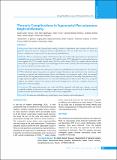Please use this identifier to cite or link to this item:
https://hdl.handle.net/20.500.14356/891| Title: | Thoracic Complications in Supracostal Percutaneous Nephrolithotomy |
| Authors: | Kunwar, Ashok Kumar Upadhyaya, Amit Mani Tiwari, Kabir Shrestha, Sanjesh Bhakta Yadav, Chandra Shekhar Dangol, Bikkin Shrestha, Parash Mani |
| Citation: | KunwarA. K., UpadhyayaA. M., TiwariK., ShresthaS. B., YadavC. S., DangolB., & ShresthaP. M. (2022). Thoracic Complications in Supracostal Percutaneous Nephrolithotomy. Journal of Nepal Health Research Council, 20(02), 361-365. https://doi.org/10.33314/jnhrc.v20i02.3950 |
| Issue Date: | 2022 |
| Publisher: | Nepal Health Research Council |
| Keywords: | Percutaneous nephrolithotomy Pleural injury Stone clearance Supracostal puncture |
| Series/Report no.: | April-June, 2022;3950 |
| Abstract: | Abstract Background: Due to the risk of pleural injury leading to thoracic complications, many urologist still hesitate to perform supracostal puncture during percutaneous nephrolithotomy. Our aim of this study was to evaluate the thoracic complications in supracostal access percutaneous nephrolithotomy. Methods: This is a retrospective analysis of 101 patients who were treated with supracostal access percutaneous nephrolithotomy at our institute from September 2013 and December 2019. Indications for supracostal punctures were staghorn 28(27.7%), middle calyceal stones 10(9.9%), pelvic stones 29(28.7%), complex inferior calyceal stones 26(25.7%), upper calyceal stone 10(9.9%)and upper ureteric stone17(16.8%).The intercostal space between the 11th and 12th ribs was used in all the cases. Results: Among the 101 patients who undergone percutaneous nephrolithotomy by supracostal access, three patients (2.97%) had pleural injury. Among them one patient developed hydrothorax and needed chest tube insertion and remaining two patients had minimal pneumo thorax with blunting of costo-phrenic angle, which was managed conservatively. The lung parenchymal or other viscera injury was not observed in our study. Most punctures were, a single supracostal superior calyceal access 18(17.8%) and middle posterior calyceal access 88(82.2%), except for staghorn and multiple complex lower calyceal calculi needed multiple tracts 23(22.8%). Complete clearance was observed in 77(76.2%) patients. Conclusions: The supracostal puncture was a safe and effective approach with high stone clearance rate and acceptable morbidity in selected cases of staghorn, upper ureteral, and upper calyceal calculi. It should be adapted whenever needed and should not be avoided due to fear of chest complications. Keywords: Percutaneous nephrolithotomy; pleural injury; stone clearance; supracostal puncture |
| Description: | Original Article |
| URI: | http://103.69.126.140:8080/handle/20.500.14356/891 |
| ISSN: | Print ISSN: 1727-5482; Online ISSN: 1999-6217 |
| Appears in Collections: | Vol 20 No 02 Issue 55 April-June, 2022 |
Files in This Item:
| File | Description | Size | Format | |
|---|---|---|---|---|
| 3950-Manuscript-29680-1-10-20221103.pdf | Full Article. | 262.21 kB | Adobe PDF |  View/Open |
Items in DSpace are protected by copyright, with all rights reserved, unless otherwise indicated.
